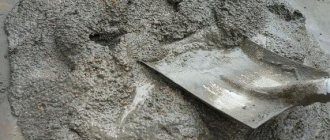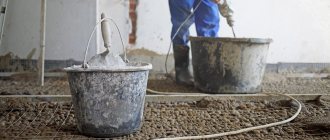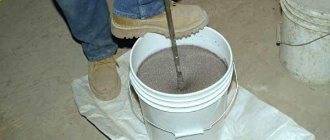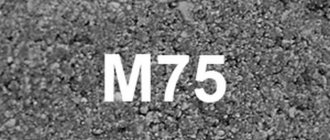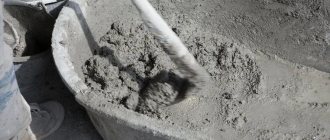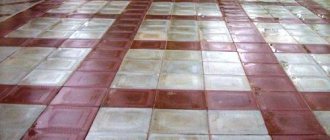Today on the construction market there are many dry mixes designed to significantly facilitate and speed up the work process. The basis for their production is cement and sand, to which plasticizers are added in production to improve the technological properties of the finished solutions. The consumer only has to open the package, pour out the required amount of material, add water and mix until a homogeneous mass is obtained.
One of these materials is “M-150”. The dry mixture of this brand is produced for different types of work - installation, laying, finishing.
Peculiarities
Thanks to the use of special technologies in production and the optimal ratio of components, the material acquires unique qualities that are extremely important and necessary during repair work or construction. This:
- Reliability.
- High quality.
- Excellent degree of adhesion to various types of substrates.
- Economical consumption.
- Moisture resistance.
- Versatility. The material can be used for external and internal work.
- Frost resistance.
- Vapor permeability.
- Good sound insulation and heat saving properties.
The weight of the package in which the dry mixture “M-150” is produced is 50 kg.
What does the certificate tell you?
Let's immediately clarify why it may be needed? First of all, this paper should be obtained by those who are going to produce a cement-sand mixture. It will also be interesting for the buyer. What does the document say?
It contains information about the compliance of the substance being sold with the requirements set out in GOST and other regulatory documents. It is called “Certificate of Conformity for Dry Mix M150”.
What kind of information is this? The document not only talks about the purpose of this product, but also states:
- density of matter;
- initial moisture content of the mixture;
- range of permissible temperatures for use;
- specific gravity;
- plasticity and delamination parameters;
- frost resistance indicator.
Indicators of the average consumption of the substance for certain types of work with the solution can also be added here. A necessary point is the safety of the material for humans and the environment.
Material advantages
The undeniable advantages include many positive properties.
Among them is the ability to create an even layer. This is a very important factor when plastering, laying walls and other work. Chips and cracks do not form on the surface of the finished layer. But this is only possible if no errors were made during the preparation of the solution and its application. The high strength of the dried mortar allows the use of this brand of material when laying stone, both artificial and natural. After hardening, the entire area to which the solution was applied remains uniformly dense.
In addition, due to the fact that the mixture is highly frost-resistant, it can be used in all regions of the country, including the northern ones.
Characteristics of properties and advantages
The high-quality modified composition of Portland cement M150 and the mineral additives included in the composition, in a strict percentage ratio, have a positive effect on the quality of concrete and reinforcement. The unique property of plasticizing additives is to liquefy the concrete mixture, thereby increasing the plasticity of the material.
According to GOST 25192-82, sand concrete is considered a quickly hardening, high-strength building material. The homogeneity of the mass and increased density of the solution is ensured by the dense, fine-grained river sand included in the composition. The strict proportion of which practically does not cause drawdown.
Sand concrete m150 is a certified building material and almost always has a certificate of compliance with environmental characteristics.
The versatility of the composite material lies in the fact that it has proven itself excellent both in interior and exterior finishing work. List of quality characteristics of sand concrete mixture:
- High homogeneity of the solution over the entire area;
- Increased strength;
- High anti-corrosion properties;
- Due to the high plasticity of the composition, the solution has convenient placement;
- High solution density;
- The frost resistance and water resistance of sand concrete 150 is ensured by the additional mineral additives included in the composition;
- Fast hardening, allowing you to get maximum results in the shortest possible time;
- Universal material, does not require additional reinforcement (layer up to 30 mm);
- High adhesion (adhesion to various surfaces and materials);
- Low abrasion significantly increases service life;
- Not subject to the negative effects of weather conditions, does not delaminate;
- The final big plus is complete reliability and economical costs.
The modern construction market offers several varieties of dry concrete mixtures of different brands; depending on the fillers they contain, the mixtures can differ dramatically in some characteristics.
Let’s say what is the difference between sand concrete M300 and M150: the main difference lies in the filler; in the M300 grade, the filler is fine gravel. As a result of this, the solution acquires increased high-strength material.
Pay attention to the percentage of sand included! Some dishonest manufacturers, in order to save money, add a higher percentage of sand to the mixture, which causes subsidence and cracks on the surface.
Composition characteristics
Dry universal mixture “M-150” is a material consisting of several components taken in quantities prescribed by GOST No. 28013-98.
This:
- Portland cement. Material grade: PC 400D0. It does not contain any additives.
- Portland cement. Material grade: PC 500. Contains D20 mineral additives.
- Fractional sand. The dry combined substance contains particles in the range of 0.1-1.2 mm.
- Modifying polymer additives. They are needed to improve the binding properties and overall quality of the material.
But in order for the cement mass to preserve its properties, it must be stored correctly. The best place for this is closed, dry rooms with a temperature of 7 to 35 ° C. The permissible maximum humidity during storage is no more than 70%. But even in such favorable conditions, the material should not be stored for longer than 6 months, otherwise it will begin to lose its properties.
Recommendations for working with dry mix M150
The M150 brand building mixture in dry form is poured into a container and diluted with water in an approximate proportion of 1.8-2 liters per 10 kg of packaged product. It is better to mix with a mixer until a homogeneous solution of moderate consistency is obtained.
For masonry, it is necessary to apply a plastic composition to the surface of the block or brick and level the mortar with a trowel to the desired thickness of the layer (seam). The optimal value here is 1-5 mm, which is determined by the size and weight of a single block. When plastering surfaces, the liquid mixture is applied with a spatula or using an automated plastering station and leveled using a rule until an even layer is obtained. If the thickness of the latter exceeds 3 cm, pre-installed beacons should be used. For better adhesion, the wall must be cleaned in advance from uneven surfaces, mold and mildew, and then treated with a deep penetration primer.
Although the specification composition of factory-made domestic dry mixes is almost the same, the performance qualities of the product from different manufacturers can vary markedly. This is due to the difference in the brands of cement used, the grain size and nature of the filler, the amount of special additives and other technological factors. When purchasing a material, it is useful to study information about the manufacturer, become familiar with the full composition of a particular mixture, factory warranties, production date and shelf life.
Dry construction mixture brand M150 should be stored in packaged form in a dark, dry room at a humidity of up to 70% and above-zero temperatures (best from +10 to +35 degrees C). The product must be used within six months after purchase to avoid losing its working properties.
Features of application
Like any other material, M-150 also requires special handling.
The dry mixture must be used up after mixing within a maximum of 2 hours, otherwise it will harden and become unsuitable for application. Therefore, it is necessary to take care of preparing the surface in advance. It must be cleaned of any contaminants. Lubricating oils, grease, dust and other similar substances will reduce adhesion, and a high-quality connection is unlikely to be achieved. In addition, you need to remove those areas that are crumbling. If mosses, algae, or fungal damage occur, they must be removed and the infected surfaces treated with any of the fungicidal preparations. Those surfaces that absorb liquids must be treated with a primer. Another solution is repeated moistening, but each subsequent time it is necessary to moisten only after the previous layer has completely dried.
Preparing the mixture:
- Pour the required amount of “M-150” material into the mixing container. The dry mixture should be distributed over the bottom, after which warm water is added to it. The proportion is 1:5.
- Stir the solution until the mass becomes homogeneous.
- After 5 minutes, repeat the mixing procedure, but there is no need to add liquid.
Precautionary measures
Although the M150 mixture is not poisonous, it is made on the basis of cement, which, when in contact with water, can inflame the skin. Therefore, it is advisable to work with the solution wearing protective gloves. Contact with the eyes can also be painful.
If this happens, you should immediately rinse your eyes with plenty of cold water. If it doesn't help, be sure to see a doctor.
Do not inhale dust when working with the dry mixture, make sure that it does not get into your food.
Used empty bags should not be thrown away unattended. In addition to polluting the area, they are also dangerous for children and animals.
Scope of use
The mixture is intended for finishing work on different surfaces. These can be ceilings or walls, on which puttying, wallpapering or painting will be done in the future. But this is not the entire list where the M-150 is used. The dry mixture is used for the following purposes:
- Installation and installation.
- Leveling surfaces in reinforced concrete forms and various structures.
- Concreting.
Moreover, the mass can be applied to concrete, cement-lime, cement-sand and brick surfaces.
Price per kilogram
In addition to its technical characteristics, this cement-sand mixture is also attractive for its price, which depends on what kind of solution it is intended for preparing. Various additives also affect the cost, since some are expensive, for example, plasticizers.
It is quite understandable that adding them to the mixture will raise the price of it. So we will talk about the average price, because the final price is subject to many factors.
The price depends on the manufacturer, the composition of the mixture, delivery to the point of sale, etc. On average, a bag weighing 25 kg of M150 mixture costs 91-92 rubles per one, which is quite acceptable.
By the way, if there are mixtures with similar characteristics on sale, then before making a purchase, compare their consumption in kg/sq.m per layer thickness. It happens that a mixture that costs more will save money.
Expense and acquisition
Uninformed consumers are usually interested in how much material they need to purchase for the job if they use the M-150 dry mix. Consumption depends on the type of work performed. For example, for one sq. m area will need about 20 kg of ready-made solution if it is applied in a layer 1 cm thick.
If it is brickwork, then the results are completely different, since they depend on the thickness of the masonry material. The quantity is indicated per 1 sq. m:
- Half a brick – 25 kg.
- One brick – 50 kg.
- One and a half bricks – 75 kg
- Two bricks – 100 kg.
There are plastering, installation and masonry and dry mix “M-150 universal” on sale. A package of any type of substance weighs 50 kg: it is convenient for transportation, storage and use, but some manufacturers also produce 25 kg bags. Which option to choose depends only on the amount of work to be done and on the manufacturer’s rating. If the latter does not inspire confidence, it is better not to save money and turn to trusted brands.
Main types
In fact, the key areas of exploitation of mixtures have already been outlined above. It is they who determine the type of composition selected for use in order to solve the problem.
- Plaster. Suitable for application manually or using a machine. The permissible layer thickness is 5-50 mm. The existing mixture can be applied to façade structures or during the finishing process.
- Laying block building materials. The mixture can be used in combination with clay, silicate and refractory brick products, as well as gas silicate blocks. Repeated maintenance of freeze-thaw cycles allows the mixture to be distributed even outdoors, regardless of the weather. It is also characterized by resistance to high humidity in rooms of buildings and structures.
- Filling the screed. Designed for leveling floors on different sites. When pouring, the height increases to 10 cm, and distribution requires the use of beacons. If all proportions are met, then the consumption per 1 cm of coating is 22-25 kg per square meter. Based on concrete, such a building material is highly durable, moisture-resistant and tolerates temperature changes well.
Accordingly, it is necessary to make a purchase having previously determined the scope of purpose and method of operation based on the initial data.



